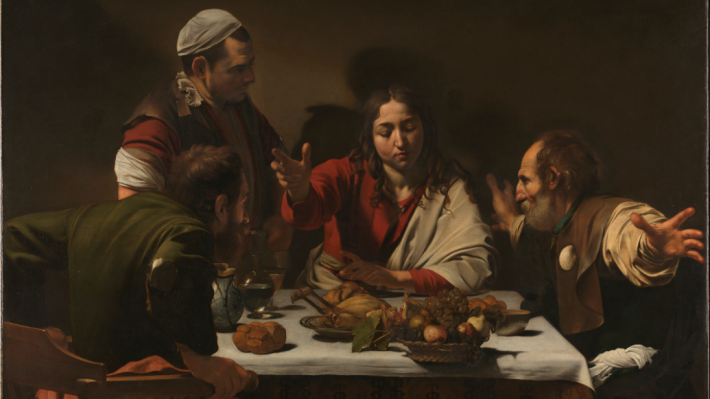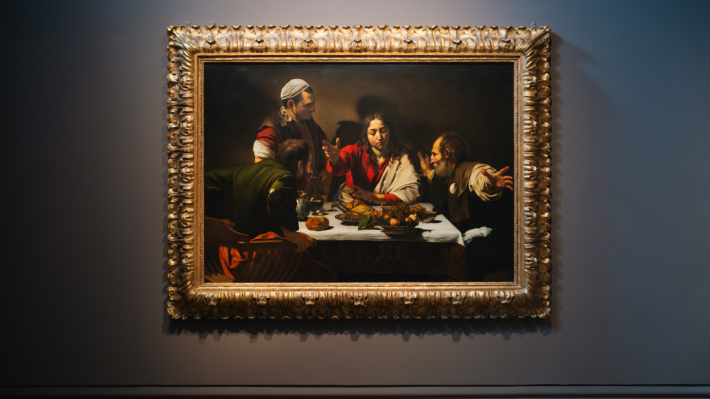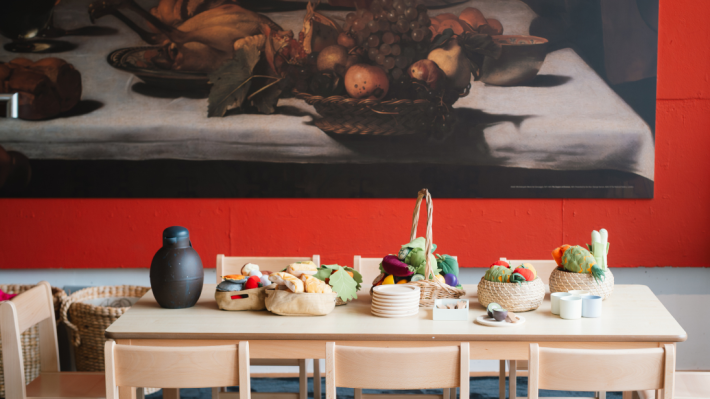This is a description of a large oil and tempera painting on canvas, called ‘The Supper at Emmaus’ by the Italian artist, Caravaggio. It is about a metre and half high and 2 metres long and dates to 1601. The intense and richly colourful painting depicts Christ seated at a square table which is laden with bread, fruit and meat. He is joined by two disciples, seated to his left and right and an innkeeper stands close by, ready to assist them. The subject is taken from the Gospel of Saint Luke in the Bible.
After Christ’s resurrection (when he was brought back from the dead) he walked to Emmaus near Jerusalem with two disciples. The men only recognised him when they dined together, and Christ blessed the bread. In this painting Caravaggio depicts that moment of astonished recognition.
The painting is displayed in a solid gilded frame, the shining surface of which contrasts with the darker tones. Caravaggio manipulated dramatic contrasts between light and dark, referred to as ‘chiaroscuro’ in Italian, to underline the drama of the scene which takes place in an otherwise very ordinary environment. The plain grey background focuses our attention on these four male figures gathered around the table.
Christ is seated at the centre of the composition, behind the table, and facing us. His long brown curly hair cascades over his shoulders. His eyes are cast down and his youthful skin, emphasised by the fact that he is beardless, is illuminated. Wearing red and white robes, his right arm is raised, extended out towards us, whilst his left rests on the table, his hand held over a small loaf of bread in an act of blessing.
The two disciples sit across the table from Christ, they wear clothes contemporary to the 16th century. To Christ’s right, is an older man with a rugged profile, a hooked nose and receding hairline. He has sparse dark hair and a grey beard. He wears a brown tunic over a white shirt with rolled up sleeves. His arms are outstretched. His body forms the shape of a cross, a specific reference to the Crucifixion. Caravaggio’s realistic style creates the illusion that we could take the hand nearest to us as it appears to extend out of the painting into our real space. This man wears a scallop shell brooch, an emblem of a pilgrim. He is sometimes described as St Peter. St Peter was later crucified in Rome which gives heightened significance to his pose.
In the lower left corner of the painting the second disciple is dressed in a green jacket and coral trousers. He is thought to be Cleophas. Seated with his back to us, facing Christ he grips the arms of his wooden chair, as if to stand. His elbows are bent. Caravaggio has added the charming detail of a rip in his sleeve. Although much of his face is hidden, the tension in his arms and his expression communicates shock and surprise as Christ is revealed.
The inn keeper, standing on the left of Christ, is unshaven and his head is covered with a white cap. He’s dressed in plain brown clothes with hints of red and white at the sleeve that echo the colour of Christ’s robes.
The table is covered by a white cloth on top of an opulent, patterned rug in tones of brown and gold. It is populated with beautifully observed fruit including apples, grapes, and a pear, arranged in a basket. Small, simple loaves of bread, a carafe of water and a roast bird are arranged on the table. They all have symbolic associations.
The painting offers the viewer an invitation. There is a space left empty at table for us to join the group. Christ’s raised hand, in the act of blessing, also pulls us in to this space. If we were to sit, we might notice that the bowl of fruit in front of us casts a fish-shaped shadow on the crisp white tablecloth, again a reference to Christ. It is also another example of Caravaggio's skilful use of light and shadow. This choice is not just about rendering realistic depictions and symbolic significance in his paintings, but also skilful illusion and techniques to engage and captivate viewers.



